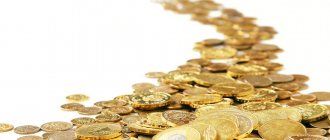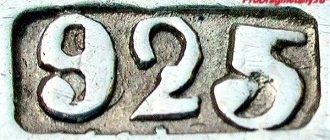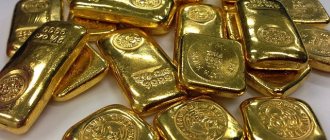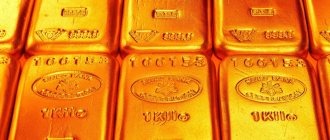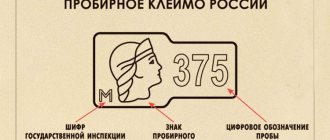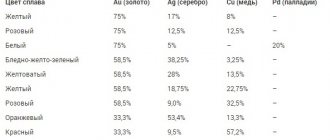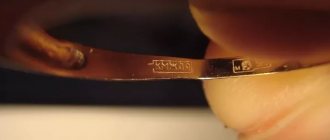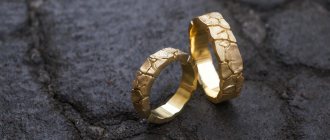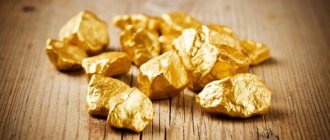The list of the most expensive metals on the planet is unusually short. And gold is rightfully included in it. Rare, beautiful, practically eternal - although why “practically”? – gold has passed all stages of selection and not only adorns the list of precious metals, but is also a permanent favorite of the people.
Especially regarding the issue of wedding rings. They say about gold: “An eternal metal – for eternal relationships.” Isn't this a hint to future newlyweds which metal to turn to when choosing the most important jewelry?
Gold is very soft. It melts at a temperature of only 1063.4° C. It is practically plasticine. Just imagine, just 28.3 grams (1 ounce) is enough to produce a wire five kilometers long or the thinnest blanket with an area of 9.3 square kilometers!
It is logical that it is not used in its pure form for the production of jewelry - this would be completely impractical. Therefore, pure gold is mixed with other metals - for strength, among other things, but also to improve casting properties and give different shades. Impurities of metals involved in the alloy are called alloys. So, depending on the amount of ligature, the gold alloy can acquire the familiar shades of yellow, red or white.
Carats and fineness
The purity of gold is measured in karats and fineness. 1 carat is equal to 1/24 of the alloy weight. For example, 24 karat gold (24K) is pure gold without any impurities. And 18-karat gold (18K) means the alloy contains 18 parts gold and 6 parts impurities.
In Russia, the metric system is adopted: the purity of gold is measured by its fineness. The fineness ranges from 0 to 1000 and shows the gold content in parts per thousand. Gold of 999.96 purity is considered “virtually pure”; this is the value indicated on the bars. The most popular hallmarks of gold products: 585, 750 and 958. “Translation” from karat language to hallmark language below:
23 K = 958 hallmark (share of pure gold 98.5%) 18 K = 750 hallmark (share of pure gold 75%) 14 K = 585 hallmark (share of pure gold 58.5%) 12 K = 500 hallmark (share of pure gold 50 %) 9 K = 375 standard (pure gold content 37.5%).
Pure gold is always yellow, but the color of the alloy can change depending on the amount of impurity. Typically, jewelry gold contains copper, zinc, silver and nickel.
Gold jewelry comes in a variety of colors, and popular shades may vary from country to country. For example, in jewelry stores in Europe, America or Eastern countries it is easier to buy a wedding ring made of yellow gold, due to its greater popularity. In our country, this metal is still a rarity, and not every store will offer jewelry made from it. However, there have always been connoisseurs of yellow gold among our compatriots; people prefer this color as the closest to natural. Plus they like the rich sunny shade.
Gold samples in Russia
In Russia, since 1700, according to the Decree of Peter I, a spool-type measure of calculating precious metal was in effect. They were equal to the values 56, 72, 92, 94. Or, a piece of jewelry with 72 purity of pure gold contains 72 shares of precious metal and 24 shares of alloy in 1 pound (96 shares of spool).
The change from the measuring spool system to the metric one was introduced in Russia in 1927 during the transition to international measurement standards. Of all the samples that exist in the modern world, metric has the most accurate scale for assessing the metal content in a product. Samples in Russia are determined according to state standard No. 30649-99.
The color depends on the percentage composition of the ligature. Even within the same sample, the color of a product can have significant differences. Increasing the copper content gives shades from reddish to orange, and silver – white and greenish shades. So-called “white gold” is obtained by using a combination of silver and palladium in the alloy. When purchasing a piece of jewelry, you can find out what standard it is by using the mark that is applied to the product by the manufacturer during its production.
What affects practicality
Precious metals are soft, and to regulate this quality, base metals are added to the alloy. And the more other metals in the composition (the lower the sample), the more practical it is considered. You should not think that such products are not susceptible to scratches - scratches during wear are inevitable in any case, but they are less deep, and some can be removed with a simple polishing cloth. Nevertheless, high-grade products are very popular - because even if their surface is damaged during wear, it can be easily restored in a jewelry workshop.
Properties depending on impurities
The table of silver samples shows the properties and main characteristics of the alloys that are used most often.
| Try | Compound, % | Advantages | Flaws | Scope of application | ||
| Silver | Dopants | |||||
| 999 | 99,9 | 0,01 | High ductility | Easy to bend or break, oxidizes and darkens | Bullions and collectible coins | |
| 960 | 96,0 | 4,0 | Does not oxidize in air | Quickly loses attractiveness | Jewelry | |
| 925 | 92,5 | 7,5 | Retains its shape well and allows for filigree work, beautiful white shade | Softness | Jewelry | |
| 916 | 91,6 | 8,4 | Does not oxidize in air | Loses its appearance quickly | Jewelry, cutlery covered with enamel | |
| 875 | 87,5 | 12,5 | Increased strength | Inability to perform fine jewelry work | Household silver, cutlery, economy class jewelry | |
| 830 | 83,0 | 17,0 | High strength and casting qualities | Easily oxidizes and darkens, has a yellow tint | Dishes | |
| 800 | 80,0 | 20,0 | High strength and casting qualities | Rapid oxidation and yellowish tint | Cutlery, household items | |
| 777 | 77,7 | 12,3 | High hardness, strength and ductility; rich color and pleasant shine | Not in any sample standard | Jewelry industry | |
Precious metals include silver with hallmarks:
- Ag 999;
- Ag 960;
- Ag 925;
- Ag 916;
- Ag 875;
- Ag 830;
- Ag 800.
Alloys with a purity lower than 800 are in most cases not marked and are not considered jewelry metal. Nevertheless, such products are found on the Russian market.
Which rings to choose?
A little trick - if you want your engagement ring to require minimal maintenance, choose textured options. Patterned jewelry also wears out, but due to the texture it is not noticeable. A good example: Ring Studio wedding rings in the shape of twigs, dragons, checks, or any other piece with a rough texture.
If this design is not close to you, look at the fingers of foreign movie heroes. An attentive viewer will notice the characters’ preferences: round paired rings with a comfortable fit, “washers,” jewelry with a diamond path.
Similar gold rings can also be seen in the Ring Studio showcases in Moscow and St. Petersburg. But you don’t have to come, photos of all models are posted on the website, so it’s easy to order them online.
Differences from 925 silver
Another common type of silver is 925. Its main features are a greater amount of noble metal and the absence of yellowness. It contains 92.5% silver, and therefore the products are more expensive.
Most jewelry is made from 925 grade metal. It is more flexible than 875 and allows you to create elegant, openwork accessories. It shines with a noble silver-white hue, which cannot be said about the 875 sample, which has a slight yellowness.
Tips for choosing silver jewelry
Silver jewelry, although an inexpensive accessory, can look very impressive if chosen correctly.
Some tips for choosing them:
- You need to buy from trusted stores. The product must have a clearly visible sample and a sealed tag;
- You must first try on the product. If this is a ring, then you need to know the exact size;
- silver is especially suitable for fair skin, blue or gray eyes, black or platinum hair;
- If there is an official event, a business meeting, or a trip to the beach, then silver items are preferable.
Of the stones, white metal is best combined with emerald, sapphire, lapis lazuli, agate, amethyst, onyx, and malachite. But it is not friendly with zircon, amber and tourmaline.
Sample 875 with a star - what is it? Alternative labeling
During the Soviet era, the sample in question had a special marking. The Soviet standard 875 had a special sign - it was a star. Today, products with this mark are especially valued for two reasons: firstly, many decorative items or tableware are not produced at all today. Such things have received the status of rarities, that is, those that are rarely found, and many exist in several copies. This fact significantly increases their cost. These are, for example, vases, ashtrays, cup holders. During the existence of the Soviet Union, and more specifically, from 1958 to 1994 inclusive, 875 hallmark silver items were stamped with a star. Secondly, if a product has a star, this in itself is a guarantee of quality. And speaking in general terms, this fact is not related to GOST. Today, all alloyed compounds are produced with good characteristics, and all work is carried out in compliance with GOST. However, there is one thing... Most of the precious metals are imported, and imported alloys, among which Egyptian and Turkish can be especially distinguished, unfortunately, very often contain a smaller percentage of the precious base than required by the standard. So we ask ourselves the question: “Proof 875 with a star: what is it?” In the classical sense, these are silver products that were made in the USSR. But there is an alternative to this marking, when the sample is 875 with a star. What is this? These are not exactly high-quality modern fakes.
How to recognize silver?
After we have dealt with the question, 875 standard - what is it, gold or silver, we will find out how to distinguish the first precious metal from the second. First of all, you need to pay attention to the cost of the product: the price of silver is an order of magnitude lower than the cost of gold. Silver is very popular, and that is why it is very often counterfeited. Aluminum, zinc and even lead are used for these purposes. There are also cases when products are lightly coated with a silver layer. Pay attention to the presence of a stamp: if it is erased or is not clearly visible, this is a fake.
Not always purchased silver items can be considered counterfeit if they turn black. In this case, toothpaste will help restore them to their former shine. The quality of a product can be checked in several ways. First of all, this is not only the presence of a mark, but also its numerical value, do not forget about the peculiarity of the type of print itself, which has the shape of a barrel. Professionals in their field can very clearly distinguish silver from gold. This is due to the fact that white gold products contain palladium and platinum, which give a unique cool tone, and silver products, as you understand, include less expensive metals, such as copper. When combined with silver it gives a completely different shade.
Using new technologies, spraying can be done so professionally that it is impossible to do without special reagents. In this case, you may also need the help of a jeweler. There is another ancient, even barbaric way to distinguish between silver and gold: drop iodine on the product. If you have gold in front of you, you will see a dark spot on its surface. If it turns out to be silver, the surface will become significantly lighter.
Advantages and disadvantages
The advantages of the 875th sample include low cost. Using rhodium plating and plating, stylish, beautiful jewelry is obtained. You can flaunt such jewelry at banquets and social events. Low tendency to oxidation, blackening, strength are the positive aspects of the material.
Insufficient ductility and difficulty in processing are the weak points of 875 silver. It is more difficult to create elegant crafts from 875 standard than from sterling. Excessive hardness interferes with fine processing, so 875 silver is more often used in industrial jewelry production.
Application of this alloy
Jewelry for undemanding customers is made from the material described. 875 is stronger than 925, so it is harder to process. Rings, chains, bracelets, rings - this is the assortment of the 875th sample. Gemstone inlays are not uncommon for this material as it can hold them.
Also, the 875th sample is used to make tableware and candlesticks. No matter what year it is, silver tableware always remains a prestigious feature. Back in the late 19th and early 20th centuries, many houses and restaurants were furnished with silver sets.
But with the increasing costs of their production, as well as the need for constant cleaning, they were supplanted by their more practical counterparts. Cigarette cases, ashtrays, cup holders, and shot glasses are now common.
Where can you buy or sell
You can buy 875-grade silver in numerous jewelry stores and pawn shops. Their addresses can be found on the Internet. Read reviews before purchasing. You can sell them in the same organizations.
How much does 1 gram of silver of this standard cost today?
The price changes every day and is set by the Central Bank of Russia. You can find it on the bank's website. Moreover, the price of the 999th sample is indicated. It needs to be multiplied by 0.875, and the cost of a gram will be 875 marks. For convenience, I suggest using a “live” graph and table.
| Price 999 standard according to the Central Bank | Market value of the sample today | Scrap price | Price in jewelry |
International silver standards
- 1000 is the standard used in Japan. The purest sample in the world.
- 980 – in Mexico.
- 970 – in Mexico.
- 959 – in the Czechoslovak Republic and the Czech Republic.
- 950 - in Great Britain, France, Japan, USA, the Netherlands (used until 1814), Switzerland, Yugoslavia, Bulgaria, Romania, Hungary.
- 940 – in Mexico and Poland.
- 935 – in Austria, Germany and Switzerland.
- 934 – in the Netherlands (until 1953).
- 930 – in the Netherlands, Germany, Israel, Palestine.
- 925 - in Great Britain (Sterling), USA (Sterling - since 1870), Ireland - (Sterling), Denmark (since 1893), Israel. Current international standard.
- 916 – in Finland, Poland (after 1963), Portugal (after 1886), Russia (88 Zolotniki), Romania and Spain (before 1934), Latvia.
- 915 – in Spain (until 1934).
- 900 - in the USA (coin - before 1870), China, Argentina, Germany, Switzerland, Italy, Yugoslavia, Czechoslovakia, Hungary, Japan, Egypt, Turkey and Lebanon.
- 875 – in Russia (84 Zolotniki), the Baltic countries, Poland, Finland, Switzerland, Romania, Latvia.
- 844 – in Denmark and Norway.
- 840 – in Iran.
- 835 - operated in the territories of Germany, the Netherlands, Belgium, Austria and Portugal.
- 833 in Portugal (after 1886), the Netherlands (before 1953), Denmark (after 1800) and Norway.
- 830 - in Norway (after 1892), Denmark (after 1972), as well as in Finland, Sweden and Portugal.
- 826 – in Denmark (from 1893 to 1972), in Norway (until 1892).
- 813 – in Germany, Finland.
- 800 – was popular in the countries of the current European Union until 1814.
- 750 – in Germany and Prussia, in Italy, Yugoslavia, Czechoslovakia, Bulgaria, Poland, Hungary and Romania
- 700 – in the state of Lebanon.
- 687 – in Germany.
- 625 – in Germany.
- 600 – in Egypt.
All of the above data on silver samples were used by jewelers from different countries in different time periods. From the presented list, some values are valid in our time and differ from each other in the international system of standards.
